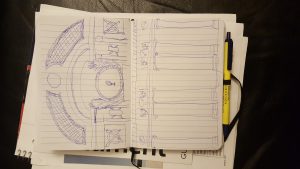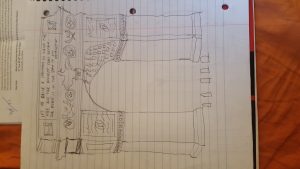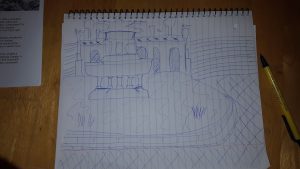Week 7 notes and sketch of Brooklyn bridge
Author: aleksandar (Page 3 of 4)
Frick Museum and Guggenheim museum
Central park development brings the wealthier New Yorkers to the 5th avenue looking for prime real estate in New York City. Thanks to them, now we have several large-scale houses next to Central Park, built by Carnegie, Kahn, and Frick. Some of those houses become museums, like the Frick museum. But there was still a place for the development of new buildings in this area in the mid-20th Century like designed museum Guggenheim.
Frick museum was built to become the museum just after the owner dies. Henry Clay Frick was collecting arts from all over the world, and today we can see pieces of Rembrandt of Francisco Goya in this museum. The Frick is one of the first small art museums in the United States. It has a high-quality collection of old paintings as well as dozen sculptures, porcelain, and 18th-century French furniture and oriental rugs. It has 19 showrooms which are sometimes hard to follow. House is square with many side rooms and central garden, built-in ancient Rome style.
On the other side, the Guggenheim building was designed to be an only museum, nothing else. It is an art museum with the collection of Impressionist, Post-Impressionist, early Modern and contemporary art. It was designed by Frank Lloyd Wright, and at that time very controversial. It is a cylindrical building, wider at the top than the bottom and was conceived as a “temple of the spirit”. Its unique ramp gallery extends down from just under the ceiling skylight in a long, continuous spiral along the outer edges of the building to the ground level. In some parts, it was modeled by Pantheon in Rome, with its round shape of building and oculus at the top of the roof.
Both museums are state of the art for themselves. Frick Museum is a presentation of an old museum with several side rooms and a lot of art packed in a small area, while Guggenheim is representing modern museum with a round cylindrical gallery that starts on top and ends at the bottom. Space in the Frick museum is better for displaying the art pieces because of the existence of corners and flat walls, while that is not a case in Guggenheim because of the curved walls and organic forms. Frick museum was built in 18th-century European style architecture, while Guggenheim was built from concrete in modern organic style. Both of these museums are amazing and represent one whole within the museum mile and without each other, they will not be that popular.
19th Century New York Neighborhoods and Architecture in Washington Square
The real feeling of the 19th-century development in New York City can be seen in and around Washington square park. The necessity of having open spaces in the city starts in the 19th century by creating Washington square park. Also, development north and west from the park creates one of the most preserved areas until these days of early New York architecture. South of the park, there is Soho neighborhood with efficient and appealing cast iron industrial buildings. All these differences make this district unique.
Washington Square Park was a graveyard for the poor people in 1811, at the time when the city was only developed south from it. It is located at the end of 5th avenue and 8th street. When the city bought the land around it, it creates a beautiful park with very desirable housing locations. With the construction of the Arch, the place becomes uniquely recognizable throughout the city. Today, at the same time, it is a meeting place for protestors, street performers and entertainers, overall a place where anybody can express his opinion like it was in ancient Greece.
Area north and west from the park is one of the most representative areas of New York City in 19th-century architecture. There we can see these much taller buildings than before in several architectural styles. The use of rustication on bricks on lower levels is typical for this period, where architects of these buildings are inspired with classical revival styles, in this case, the Italian revival style. There is a lot of beautiful decorative ironwork that adorns the front of these buildings. New York Public Library was built as the Third Judicial District Court House in Victorian gothic style. All the religious buildings in the 1850s and 1860s were built in the gothic revival style. What is specific for these buildings is that the architect uses weights on top of the buttress in order to hold the wall from falling. And the size irregularity of the streets in this area, with 50feet instead of 60feet wide streets, creates small pockets of unused areas that become tiny triangle parks.
Like the city needs the parks and open spaces, it also needs entertainment. Soho becomes a red-light district with theatres and hotels. Over time that leads people to abandon this area. With the invention of elevators, industrialists saw the potential of this area and move in. They build taller industrial iron cast buildings, with tall floors and big windows. In this area, we can see a unique example of Louis Sullivan’s classic Chicago style building. He uses terra cotta material and other innovative products that allow faster construction. Also, this area is decorated with several streets in which we have beautiful facades made in different styles and by different architects.
All this area is the biggest chunk of the intact landmark zone in New York City. I am glad about that because when I walked throughout this area, it shows me the way how a city developed and how people lived in at19th Century. I have a sense like I relive the history of this city in one walking tour which shows me several architectural styles in such a small area. It is very interesting that even in the heart of the busiest city in the world, there are still isolated zones that are totally traffic-free and noise oasis.
Week 4
Mid 19th Century Civic Improvement: Central Park
For me, Central Park is one of the wonders of New York City. It is one of the most visited places in the city. With the rapid urbanization, there was civic development and improvement of life in the city. That includes more parks and recreational areas that allow a healthier environment for residents of New York City. The need for creating major public parks was crucial in the mid-19th Century. Also, the design of the park itself makes it more attractive to visitors. Attractiveness is achieved with several features that complete the picture of the park as an iconic place in New York City.
In 1853, the New York State Legislature made a law to use 750 acres of land in Central Manhattan to make the first major landscaped public park. This will improve public health and create a civic society, the same as in European cities.
In competition in 1858, Frederick Law Olmsted and Calvert Vaux won first place in designing Central Park. In rectangle Central Park, they planed landscapes of vast meadows and huge water surfaces. They use rectangle shapes to perfectly set all these elements of nature in one park area. They include several other elements of nature to have diverse areas, like dense planting woodlands, meandering streams, and rockwork which include caves, grottos, and cascades. All this is the opposite of everyday congestions and crowded conditions in the city.
To develop civic socialization, designers created features that will draw people to the park. The Central Park Mall is a pedestrian esplanade which provides the only purely formal feature in the naturalistic original plan. Two-tiered esplanade features elaborate carvings and a central sculptural fountain called Bethesda Fountain. That eventually became Angel of the Waters when American artist Emma Stebbins was awarded the commission. Designers also include a vast field called Sheep Meadow with grass and nothing else. Park also includes several roads which are cleverly camouflaged behind dense vegetation.
Whenever I go to Central Park, I am amazed at how it can exist an oasis of peace in the center of one of the biggest cities in the world. There is plenty of space for walking, biking, hiking, enjoying nature and everything is well design and cleverly separated from traffic and overcrowding. Park attracts many artists to create there, many families to have a peaceful time with their children and many visitors of New York City to take a break from the busy city tour.
An immigrant city: Urban Population Explosion
Housing Stress in emerging New York City
New York was the biggest harbor in the United States from the very beginning. That meant that the biggest immigration was coming to the United States through this city. Foreign-born made up one-third of the New York population. With these many people settling in the city, comes a lot of problems with overpopulation. First one related to the lack of windows. Then, we have a house lot size and its change from single to the multi-family house. And, the importance of lights and air and its distribution and impact on life quality.
To make the most profit of its property, early house owners did not care about the tenants. They rent their rooms and basements, and small backyard barracks to several people. Those houses did not have daily sun exposure, nor sun ever penetrate those places. Also, the buildings were too close to each other and set the shade on other houses even though they have windows, so there was no chance for light to go through those windows.
The problem also exists with the property lot size and with the height of the buildings. The lot size was 25x 100 feet. Everybody tries to use all that space and did not allow space for windows, of for natural air ventilation. That help in developing the epidemic diseases. Also, there was no control of how much height certain building can have, and that produce overdevelopment.
All these things create an unhealthy and inhuman situation for the tenants and jeopardize the whole city. The area in Manhattan between Brooklyn Bridge and Manhattan Bridge was called “Lung Block” because it has a high tuberculosis mortality rate caused by unhealthy and overcrowded place for living.
With a lot of sacrifice from the immigrants over the years, the city manages to improve living conditions step by step to create a healthy environment for its citizens. New legislations pass to improve housing, like every house and building need to have ventilation, halls, and stairways in case of fire, fire escapes, running water in every apartment, garbage receptacles, no cesspools, windows in every room open to yard or street. Every apartment needs to have heat from a fireplace or some other source of heat. City legislation also changes the rule for the number of people per toilet. It goes from 20 people on one toilet, to have a toilet in every apartment. They also limit the height of buildings related to the streets. Without these changes and improvements, the city will never prevail.
Aleksandar Dekic
Comparing Urban New York/Brooklyn architecture and streetscape
Development and architecture of the Brooklyn and Manhattan during its early period have a major impact from the Dutch and British style of building. With the Independence of the United States, architects try to step away from British and Dutch style and turn toward the Greek style of building. Manhattan’s major occupation was trade and commerce while parts of Brooklyn were given to wealthy families to create farms and early housing. Early architecture work in Brooklyn can be found in Brooklyn Heights. One of the earliest places developed in Manhattan was South Port.
Manhattan, with its natural position and terrain perfect for creating ports and docks, starts developing much faster and bigger. The major occupation was trade and commerce. Along with that, they support the business center with building development and landfill to extend the shoreline. On the other side of East River, parts of Brooklyn were given to wealthy and privileged families like Livingston and Smith. This Brooklyn leading landowners recognized the position and growth potential of their town and start developing the land along the waterfront with the commercial port in today’s Dumbo and Vinegar Hill, and housing development in today’s Brooklyn Heights. Parts of Brooklyn were transformed from farmland to urban land and then divided into the blocks. The blocks were then divided into the lots and given on the auctions to be sold for development of houses or if it is a bigger lot for a building.
We can find houses in Brooklyn Heights from 1830, like a brick building in Willow street and we can recognize the Flemish pattern in the way how the house was built. Each course is made up of alternate headers and stretchers. Each header, on a stretcher above and below and every alternate course, begins with a header in the corner. The door and window are also specific. The door has 4 columns with flutes, two whole columns and two half-way inside the walls, with the lintel above the door. Windows have a soldier course and they are rectangular. With the development of Brooklyn over time, we get to have a mix of houses. Next, to each other, we can see brick houses and wood houses all over the landmark places.
In Manhattan, one of the earliest places developed was South Port. There, we can see the use of Iron cast beams instead stone columns, and use of material that is more expensive, like granite or marble which is a sign of not just wealth, but also use of a material which is more resistant to a high concentration of the salt in the air. Also, at the places where we have canals which were used to transport goods to inland, now we have streets. The first floor of the building is taller than the rest of the floors which indicates that in Manhattan was used industrial and commercial way of building. Most of the buildings next to the shoreline were trading posts and warehouses. Solid stone was used to construct bigger buildings for storing the goods. Outside, buildings are riched in appearance, with a lot of decorative piers and windows. Windows are bigger on the lower levels and getting smaller toward the last floor.
The post-revolutionary Brooklyn and Manhattan show us the different styles of construction and building. Thanks to Stuart and Revett and their book on Greek architecture we can see the transfer from Flemish and English way of constructing toward Greek revival style.
Aleksandar Dekic
Compare New York and Brooklyn Urban Growth and Planning.
New York and Brooklyn go a great way from being the unsettled area covered with forest and grass to become one of the biggest cities in the world. With the Dutch and British as early settlers, the development of the city began. Manhattan developed much faster and bigger. Brooklyn has several things like terrain which made him lag in development.
Urban development of Manhattan and Brooklyn could not be possible without Dutch. Their purchase of Manhattan island and Brooklyn from the Native Americans set the cornerstone of today city. At first, it was set as a trading post. Dutch set the city to have easier access to the water, everything is turned toward that. At that time the best way of transportation and the easiest was by the boat. With the British taking over the city, it came the new name that we use today, New York. They live peacefully with Dutch settlers and continue to develop the city outside the borders of first Dutch settlement.
Manhattan developed faster than Brooklyn because of the docks and the ports. They were established in Manhattan because the terrain is better and easier to develop. At first, the houses and properties were turned toward water and everything was organized in a way that the city has public spaces, like parks, and to have access to the freshwater. It was John Randal Jr. that set the rectilinear grid of streets at Manhattan that we can see until today. Few houses were already built in the middle of the streets, but the city was determined to follow this plan.
In the same time, Brooklyn started to develop as a separate city with the smaller port but remain without any planning. Brooklyn starts late with urban development, the settlement was already established, and the roads were dictated with the terrain. The terrain was the major player in dictating the street grid and the housing development. Brooklyn never could create rectilinear grid-like in Manhattan because it was farmland. All this made Brooklyn struggle with several urban planning issues until this day.
With the construction of the bridges, first Brooklyn bridge and then the other bridges, these two separate cities merge to become one. Now when we talk about future urban growth and planning, we need to consider both sides of the East River to plan for further sustainable development, otherwise, everything else will bring us to the edge of collapse.










Recent Comments